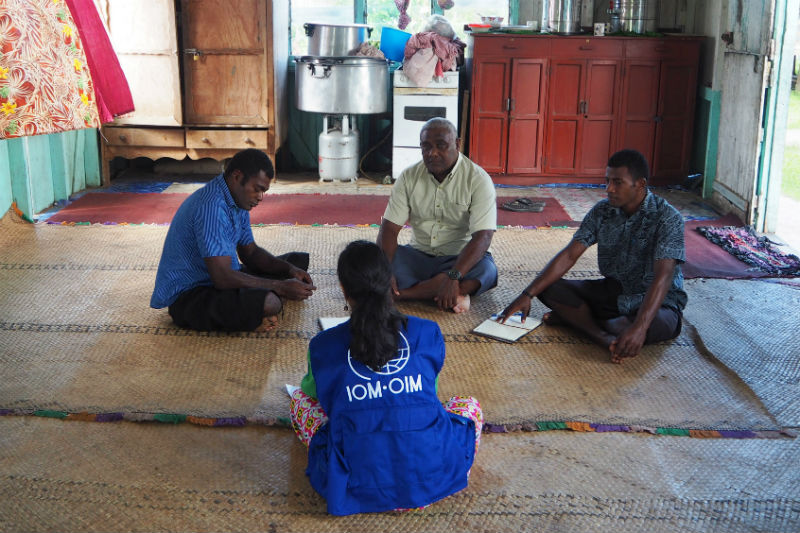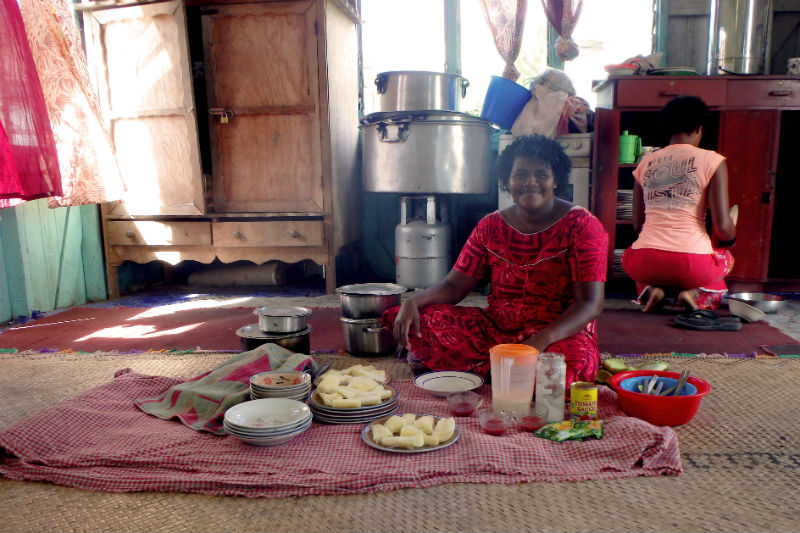Fiji
mso-fareast-font-family:Calibri;mso-fareast-theme-font:minor-latin;mso-bidi-font-family:
"Times New Roman";color:#1F497D;mso-ansi-language:EN-US;mso-fareast-language:
EN-US;mso-bidi-language:AR-SA">– The story of the sinking island has become a well-used trope in international climate change negotiations. While the vulnerability of these islands is not contested, many speculate that island populations will take flight long before the Pacific becomes uninhabitable.
With support from the government of Canada, IOM is conducting an exploratory research study to understand the links between climate change and migration in the Pacific Islands, and its potential impact on migration to Canada.
To conduct this study, the team settled on Fiji: an archipelagic nation facing strong impacts of climate change in the form of both sudden and slow onset events, but also experiencing various forms of migration, both internally and abroad. During our short stay in the country, we spoke to 13 experts and conducted six focus group sessions with the communities in Daku Village and Bau Island.

IOM Programme Associate for Migration, Sabira Coelho, conducts a focus group with three members of the community in Daku.
Fiji was born from volcanoes which can be easily deduced from its mountainous terrain. It boasts many valuable resources such as minerals and fish. For a long time, its economy depended on sugar plantations which have slowly been replaced in importance by tourism.
Despite its reasonable surface area, the country remains highly vulnerable to climate change: storms, floods, and droughts are expected to ravage the country; cyclones are expected to increase in frequency and intensity, as Cyclone Winston’s recent devastation can testify. Even more, the sea level rise is leading to coastal erosion, salinity intrusion, and ocean acidification, destroying plantations, flooding houses, and depleting coral reefs.
In the wake of cyclone Winston’s wreckage, 29 villages were forced to relocate to safer havens, moving to families’ and friends’ houses in nearby villages, and urban areas that were fairly untouched by the disaster, like Suva.
While the impact of sudden onset disasters on human mobility is fairly evident, determining the links between the people’s movement patterns and slow onset disasters such as sea level rise and coastal erosion is a much tougher task. Mobility is a way of life for many Pacific communities – in maritime Fiji, people move daily between islands to access health, police, stores and schooling services. For those who live on the larger islands of Viti Levu and Vanua Levu, they either live in and around the towns and cities or for those whose villlages are close enough to the towns, they commute by bus daily.
There were also several reports of international migration from Fiji and other Pacific islands, particularly to Pacific Rim countries like Australia and New Zealand, owing to the several seasonal worker schemes that exist, but also beyond that, to countries like the United Kingdom, United States and Canada.

A couple of women from the community start preparing the lunch feast.
We visited the village of Daku, located in Northeast Fiji, attempting to understand how climate change was affecting the population, if at all. At first glance, this was not obvious. The wooden houses in the village stood strong despite the recent cyclone that devastated nearby villages, the grass was well manicured, children lined up in the school yard awaiting instructions from the teacher. Everything seemed to be functioning normally.
“Fishing is the main occupation of the village,” explained one young man. But unlike many years ago, he continued, it’s much harder to find a good catch. There just seems to be fewer fish in the sea.
As I ate the delicate white flesh from the fish we were served for lunch, I began to understand how climate change intermingled with people’s livelihoods, affecting their income and food security, and ultimately, compelling them to move.
Despite people’s attempts to minimize the effects of climate change, either by fishing at different times or in different locations, life is getting harder. Many young people, both men and women, have decided to abandon their boats and rods, and move to the nearest city for more conventional jobs.
“For me it is better to migrate because we cannot stop the climate change,” the young man said.
At the same time, mobility is being actively employed as a strategy for reducing the exposure to climatic hazards. The government has already relocated three villages on the grounds of coastal erosion and sea level rise, with over 40 more being identified for relocation. To ensure that these are carried out comprehensively, the Government is in the process of drafting National Relocation Guidelines, which incorporate the lessons learnt. Issues like psychosocial impact and the preservation of cultural identity are taken into account before relocation begins.
For older generations, whose sense of identity is strongly linked to the land of their fathers and forefathers, migration has rarely been perceived as an option to cope with climate change. However, for youth, the issue is far more complicated as they have to take into account a sense of security that migration provides in the face of new existential threats.
I was left with a melancholic feeling – the youth have the burden of history on their shoulders. In a society like Fiji, where the land is passed on from one generation to the next, along with the responsibilities, it puts the youth in a tough position: honoring their community and forefathers by deciding to stay or weakening their links by deciding to go. While I understand that it is not necessarily a binary choice, it is still a tough choice to have to make.